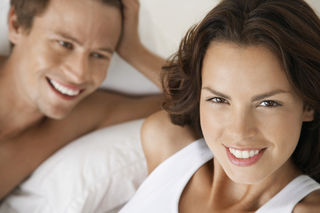Mating
3 Things You Never Wanted to Know About Sexual Attraction
... and why you may not mind finding out.
Posted March 3, 2016 Reviewed by Gary Drevitch

You probably don’t want to read this post. Spare yourself and instead share this link with someone whose sex life you’d like to temporarily ruin.
We're Attracted to Our Opposite-Sex Parents
It will come as no surprise to those familiar with Freud’s Oedipus Complex1 that our opposite-sex parents are associated with sexual attraction. However, many people, myself included, believe that they personally are not sexually attracted to their parents. While of course we may not be sexually attracted to our parents themselves, a variety of research shows that, much to our collective dismay, we are attracted to individuals associated with our parents in several ways. For example, Fraley and Marks subliminally exposed undergraduate students to photographs of their opposite-sex parents (or to photographs of someone else’s parent as a control).2 They then measured the students’ sexual attraction to individuals' facial photographs from a college yearbook. These researchers found that participants who had been subliminally exposed to the photographs of their own parents reported more sexual attraction to the yearbook photos than those exposed to photographs of someone else’s parent. Other research shows that we are statistically more likely than chance to be romantically involved with partners who resemble our opposite-sex parents in hair color and eye color,3 and that men with older parents find older faces more attractive.4
Although I trusted the conclusions of these reputable researchers, I also believed that this phenomenon did not apply to me. Conversely, however, I was able to see this tendency in other people: For example, one of my family members married a woman who looks remarkably similar to his mother in hair color, eye color, and even height. Similarly, my friend Janine* married a man who looks very much like her father. One day, I subtly discussed this research while having lunch with Janine. She found it interesting but never mentioned her own husband. As fate would have it, later that same night, Janine’s mother came over to visit and remarked that in his new glasses Janine’s husband looked very similar to her father. Janine slept on the sofa for a week. So confident was I that this phenomenon only applied to others that I brought some family photos to class with me as my students and I discussed this topic. They quickly pointed out that my husband looks like my father—and then I was the one on the sofa for the week.
We Find the Color Red Attractive Because of the Genital Swellings of Our Primate Ancestors
A variety of research shows that both men and women find individuals more attractive when they are wearing the color red.5,6,7 The color enhances (for men) perceptions of physical attractiveness, sexual attractiveness, and social status. We celebrate the color red in culture as well. (Consider the hit song "Lady in Red" by Chris De Burgh.8) Our attraction to the color red is not surprising, but the origins of that attraction may be: Researchers believe that we find the color red to be particularly sexually attractive because of our evolutionary history.

Female primates such as baboons and chimps display red on their chests, faces, and genitals when they are fertile, as a way to attract mates.5 (You are lucky I am using a photo of the red faces here. Google the genital swellings of baboons at your own risk!9)
The funny thing about the human brain is that while we are fairly good at intentionally trying to remember something, we are terrible at intentionally trying to forget it.10 The next time you see someone wearing the color red, try NOT to think about the genital swellings of baboons and chimps.
Sexual Attraction Makes Disgusting Stimuli More Palatable
If you are disgusted by any of the above topics, fear not: Recent research shows that among both men and women, sexual attraction makes disgusting stimuli seem less disgusting. Stevenson et al. found that men who had just viewed erotic images rated disgusting stimuli from a variety of senses—visual, auditory, olfactory, and tactile—as less disgusting.11 This was especially true if those stimuli were sex-related (e.g., touching lubricated condoms vs. putting your hands into a bowl of cold pea soup). Similarly, Borg and de Jong found that women who were sexually aroused (after watching short erotic video clips) were more likely to be willing to engage in disgusting behavioral tasks (sticking their fingers into a bowl of “used” condoms, placing someone else’s “used” underwear in a bag).12
The bad news: You have just learned three things you never wanted to know about sexual attraction. The good news is: If you were already sexually aroused, you may not mind ...!
* All names have been changed.
- My other posts are much less distressing.
- Portions of this post were taken from The Social Psychology of Attraction and Romantic Relationships. Copyright 2015 Madeleine A. Fugère.
References
1 https://en.wikipedia.org/wiki/Oedipus_complex
2 Fraley, R., & Marks, M. J. (2010). Westermarck, Freud, and the incest taboo: Does familial resemblance activate sexual attraction? Personality and Social Psychology Bulletin, 36(9), 1202–1212. doi:10.1177/0146167210377180 http://psp.sagepub.com/content/36/9/1202.abstract
3 Little, A. C., Penton-Voak, I. S., Burt, D. M., & Perrett, D. I. (2003). Investigating an imprinting-like phenomenon in humans: Partners and opposite-sex parents have similar hair and eye colour. Evolution and Human Behavior, 24(1), 43–51. doi:10.1016/S1090-5138(02)00119-8 http://www.ehbonline.org/article/S1090-5138(02)00119-8/abstract
4 Heffernan, M. E., & Fraley, R. C. (2013). Do early caregiving experiences shape what people find attractive in adulthood? Evidence from a study on parental age. Journal of Research in Personality, 47(4), 364-368. doi:10.1016/j.jrp.2013.03.003 https://www.researchgate.net/publication/256933387_Do_early_caregiving_experiences_shape_what_people_find_attractive_in_adulthood_Evidence_from_a_study_on_parental_age
5 Elliot, A. J., & Niesta, D. (2008). Romantic red: Red enhances men's attraction to women. Journal of Personality and Social Psychology, 95(5), 1150–1164. doi:10.1037/0022-3514.95.5.1150 http://psycnet.apa.org/journals/psp/95/5/1150/
6 Elliot, A. J., Niesta Kayser, D., Greitemeyer, T., Lichtenfeld, S., Gramzow, R. H., Maier, M. A., & Liu, H. (2010). Red, rank, and romance in women viewing men. Journal of Experimental Psychology: General, 139(3), 399–417. doi:10.1037/a0019689 http://www.ncbi.nlm.nih.gov/pubmed/20677892
7 Elliot, A. J., Tracy, J. L., Pazda, A. D., & Beall, A. T. (2013). Red enhances women’s attractiveness to men: First evidence suggesting universality. Journal of Experimental Social Psychology, 49(1), 165–168. doi:10.1016/j.jesp.2012.07.017 http://ubc-emotionlab.ca/wp-content/files_mf/elliotetaljesp2013.pdf
8 https://www.youtube.com/watch?v=FC1C4g8YOA4
10 http://www.apa.org/monitor/2011/10/unwanted-thoughts.aspx
11 Stevenson, R. J., Case, T. I., & Oaten, M. J. (2011). Effect of self-reported sexual arousal on responses to sex-related and non-sex-related disgust cues. Archives of Sexual Behavior, 40(1), 79-85. doi:10.1007/s10508-009-9529-z http://www.ncbi.nlm.nih.gov/pubmed/19705272
12 Borg, C., de Jong, P. J., & Mazza, M. (2012). Feelings of Disgust and Disgust-Induced Avoidance Weaken following Induced Sexual Arousal in Women. Plos ONE, 7(9), 1-8. doi:10.1371/journal.pone.0044111


